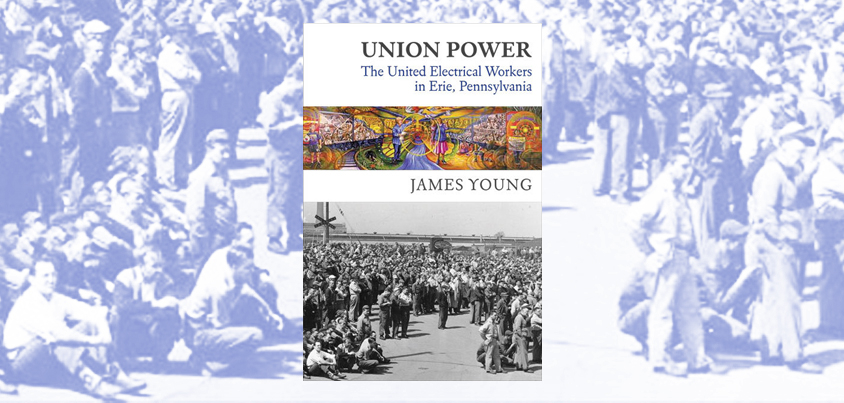Book Review: How Electrical Workers Powered Up Their Union

Union Power: The United Electrical Workers in Erie, Pennsylvania, by James Young. Monthly Review Press, 264 pp.
For unions in corporate America, it’s always been hard times. Even in labor’s heyday—the 1940s, ’50s, and ’60s—unions had to struggle for everything. Plus, back then organizers risked being tarred as stooges for Moscow.
Historian James Young makes those points clear in his readable new book Union Power: The United Electrical Workers in Erie, Pennsylvania. But the book offers more than history—it’s instructive, showing how a progressive union can survive in the incredibly hostile and toxic environment of corporate America.
United Electrical Workers (UE) Locals 506 and 618 in Erie were so progressive because they were remnants of the Popular Front against fascism, a leftist alliance of the 1930s. Popular Front-influenced union leaders politicized the rank and file through their speeches and writings, and in the course of their organizing. Many members retained a strong political awareness. That’s why for decades these two locals have continued to advocate for public policies to help all working people, including national health insurance, rent controls, price controls, and the repeal of the very anti-union Taft-Hartley Act.
Why was labor so militant in the 1930s to ’60s? This book makes clear that it was because unions had so many politically sophisticated members. Even though Fortune magazine in 1951 pronounced the left-wing influence on American unions to be dead—“there are no Wobblies today, no Jewish Bund, no Italian anarchists, no Debs, no Mother Jones,”—most average union members even then were social democrats, and many were socialists. If these members were alive today, they would have voted for Bernie Sanders, not Donald Trump.
A DEMOCRATIC UNION
It was a very democratic union, with lots of rank-and-file input. “UE organized from the bottom up,” Young observes. Instead of using full-time organizers, UE relied on “local cadres to organize themselves.”
An early organizing maneuver was to use the custodial and maintenance staff on the plant floor, who were very mobile and “scarcely supervised,” to spread the union word throughout the workplace. Local 506’s first newspaper, The Spark, “raised workers’ awareness of happenings” at General Electric and became popular with a column that “contained tidbits and bombshells of information and gossip” supplied by workers.
Once a workplace was organized, stewards were the union’s backbone on the shop floor. This was partly because, in the early days, dues had to be “collected by each departmental steward from each member and organizing proceeded the same way: one on one,” Young writes.
Local 506 tackled gender issues early and head-on, raising them in contract negotiations and putting forth many publications, a radio program, and three films on the subject. “The exploitation of women at General Electric dwarfed the problems experienced by men,” Young writes. Women’s wages were much lower than men’s, sexual harassment was rampant, and “marriage meant termination.”

SUPPORT LABOR NOTES
BECOME A MONTHLY DONOR
Give $10 a month or more and get our "Fight the Boss, Build the Union" T-shirt.
Even though UE, like other unions, made a no-strike pledge to support the World War II effort, members continued their activism by replacing out-and-out strikes with work-to-rule actions. For instance “a round-the-clock (three shift) slowdown of the piece-rate work.” Young writes that “everyone in the division worked at a pace that earned them their straight-time wage, but they refused to produce a single piece for the bonus rate.” As one unionist said, “we never interpreted ‘no strike’ to mean ‘no struggle.’”
Meanwhile a union leader promoted nationwide unionization of GE’s salaried, white-collar workers, contributing to membership campaigns across the country, and even circulated a model “Supplemental Agreement for Salaried Employees at General Electric.” Unfortunately this effort was not successful.
Union Power also chronicles right-wing attacks on the unions. Although employers can no longer accuse organizers of working for Moscow, the rest sounds very similar to what we hear today from the Tea Party, union-busting Wisconsin Governor Scott Walker, or fast food CEO Andrew Puzder. When unions push to raise wages or improve workplace safety, management’s complaints are parroted back by political hacks who try to present such demands as un-American. It’s been the same song and dance from the 1930s to today—choreographed, then as now, by the Chamber of Commerce.
LESSONS FOR TODAY
This book documents how a left populist working-class movement bettered the lives of millions of people. We’ve slid a long way backward since then. Since the Reagan years an anti-union philosophy has seized political legitimacy.
Wages have stagnated, union membership has dropped, and capital has outsourced jobs. Huge U.S. employers including Walmart remain unorganized. Millions of low-wage workers can barely eke out a living, and millions more are erroneously classified as independent contractors to keep their jobs insecure, overtime underpaid, and unions out. Whole swaths of the country have succumbed to the “right-to-work” fever, effectively neutering unions. Corporate capital has seized control of Congress, the presidency, the Supreme Court, and most of the media.
The enemy is strong. But Union Power shows what ordinary people can do to try to better their circumstances, and how we should regard the anti-union ideology that saturates our culture. This book teaches that working people can fight inequality by:
- participating in organizing drives
- striking for higher pay even when management threatens to walk away from the table
- supporting progressive union activists
- pushing for unions to support only pro-union, progressive political candidates
- recognizing the corporate media for what it is
If more people turned off Fox News and read books like this one, those who need unions—and there are many—would have a much better idea of how to get them.
Eve Ottenberg is a journalist, novelist, and longtime teachers union member.




